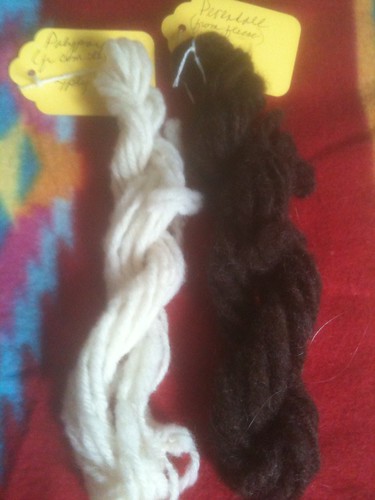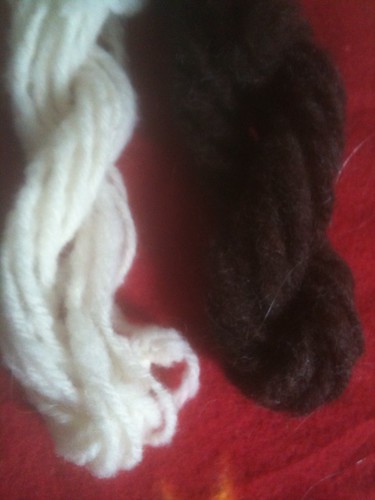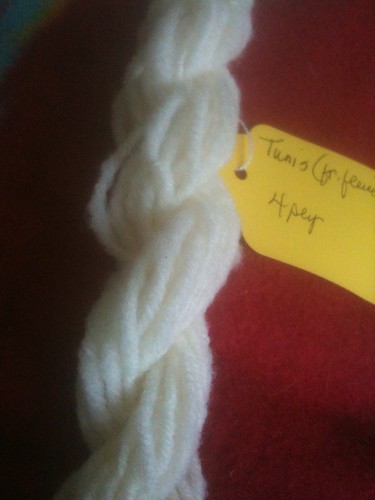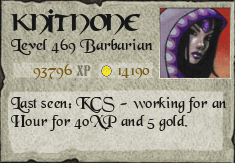The Perendale is a dual purpose (meat and wool) breed developed in New Zealand in the 1950s by crossing Cheviot and Romney breeds. It is considered a Longwool with an average staple length of five inches. Perendale has a micron count of 28-32.
My sample was listed as pre-washed Black Perendale fleece, although it's actually dark brown. It has a staple length of about 3.5 to 4.5 inches, and appears to be in the 30s on the micron/softness scale.
I chose to hand card and spin long draw for a 2ply sample which I wasn't happy with because it showed too much of the carding imperfections. So I also made a small 4ply sample which better hid my bad carding. The carded fiber was very neppy. In retrospect, I probably should have flick carded before hand carding for my rolags. Oh well, this is a learning process for me.
I think I would try this breed again, but I must admit I liked working with the Montadale (Cheviot x Columbia) much better.
Perendale (brown) 4ply sample:

Polypay
Polypal is a new US breed developed in the 1960s/1970s to provide good meat and wool and a high breeding/birth rate. This was done by breeding a Targhee/Dorset cross to a Rambouillet/Finn cross. Polypay has a medium to fine wool with a micron count of 22 to 28, and an average staple length of 3 to 4 inches.
My sample was spun from commercial top which had a staple length of 3 inches. It is a spongy wool, but not as soft as I expected considering the Targhee, Finn and Rambouillet heritage. Perhaps this particular sheep is heavy on the Dorset genes.
I tried spinning worsted from top end but that was not comfortable. So I re-carded the top and spun it long draw from the rolags on my turnip supported spindle for a small 4ply yarn sample. I would spin this again.
Polypay (white) closeup:

Swaledale
Swaledale is one of the UK mountain breeds from the Yorkshire/Lake District area. It is dual coated with an average staplelength of 4 to 8 inches, and a micron count ranging from the 30s through the 40s, depending on whether or not the outer coat is included.
My sample is from commercial top with a 4 inch staple. It is a grayish off-white with short black and white kemp fibers. A lot of the white kemp fibers shed while spinning. My guess for the micron count of this sample would be high 30s/low 40s. Definitely not a next to the skin yarn for sensitive areas.
It spun easily into two 2ply samples. The first was spun worsted from the end. The second was spun long draw from pseudo-rolags I made from the top. Both methods worked nicely.
I would spin this again. I was thinking it might make very nice thrummed mittens if the thrumming was very soft.
Top: Swaledale worsted spun; Bottom: Swaledale long draw from pseudo-rolags

American Tunis
Tunis sheep were developed from Tunisian Barbary sheep, a very old breed, with possible infusions of Southdown and Leicester blood. Tunis have a micron count of 24 to 31 and an average staple length of 3 to 6 inches.
My sample came from a 4oz raw fleece sample. Fleece did not seem to have a lot of lanolin so it washed easily. I only flicked a portion of the washed fleece sufficient for this sample. Locks ranged from one inch to three inches, with the majority in the two inch range. They were soft locks with a good deal of crimp. Normally, I would card after flicking and spin from the rolags, but as I wasn't home with access to my hand cards, I just spun semi-worsted from the locks. It spun easily with just a few bumps into a nice little 4ply sample. It was much softer than I expected. I would spin this again.





No comments:
Post a Comment